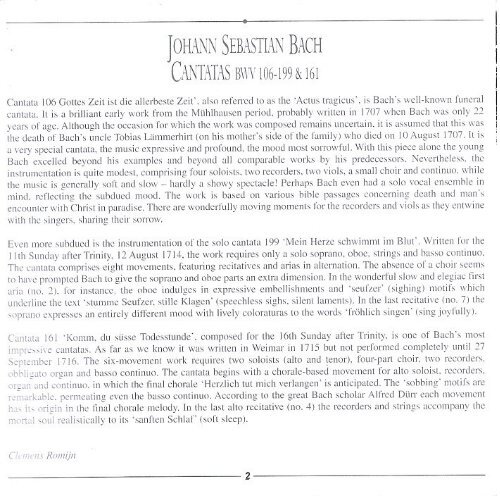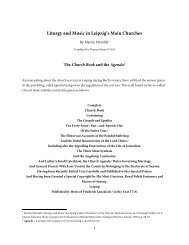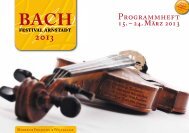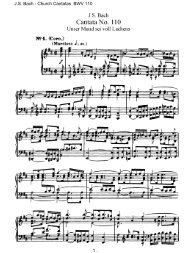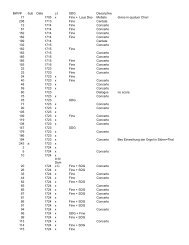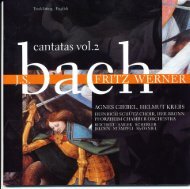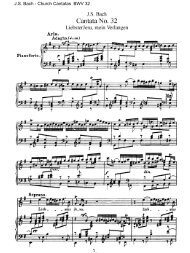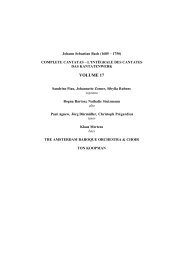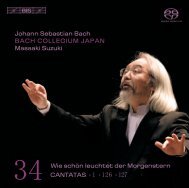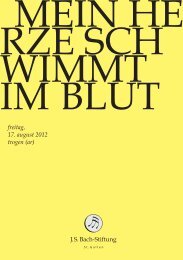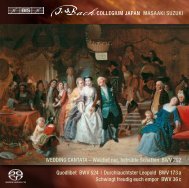Bach Cantatas, Vol. 3 - P.J. Leusink (Brilliant Classics 5-CD)
Bach Cantatas, Vol. 3 - P.J. Leusink (Brilliant Classics 5-CD)
Bach Cantatas, Vol. 3 - P.J. Leusink (Brilliant Classics 5-CD)
You also want an ePaper? Increase the reach of your titles
YUMPU automatically turns print PDFs into web optimized ePapers that Google loves.
JOHAI\-;~SEBASTIA.'\BACH<br />
CA1\JTATAS B\\'\' 106-199& 161<br />
Cantata 106 Gottes Zeil ist die allerbeste Zeit', alsoreferred to as the 'Actustragieus'. is<strong>Bach</strong>'s well.known funeral<br />
cantata. It is a brilliant early work from the Milhlhausen period, probably wriUen in 1707when <strong>Bach</strong> was only 22<br />
years of age.Althoughthe occasion for which the workwas composed remainsuncc(1ain.it is assumedthat this was<br />
the death of <strong>Bach</strong>'s uncle Tobias Lammerhirt (on his mother's side of the family) who died on 10 August 1707. It is<br />
avery special cantata, the music expressive and profound, the mood most sorrowful. With lhispiece alone the young<br />
<strong>Bach</strong> excelled beyond his examples and beyond all comparable works by his predecessors. Nevertheless. the<br />
instrumcntation isquite modest. comprising fOllr soloists. two recorders. two viols. asmall choir andcontinuo.while<br />
the music is generally soft and slow - hardly ashowy spectacle! Perhaps <strong>Bach</strong> even had asolo vocal ensemble in<br />
mind. reflectingthe suhduedmood. The work is based on varioushihle passages concerning death and man's<br />
encounter \\lithChrist in paradise. There are wonderfully moving momentsforthe recordersand viols as they entwine<br />
with the singers.sharing their sorrow.<br />
Even more subdued is the instrumentation of thesolo cantata 199 'Mein Herze schwimmt im Blut'. Written for the<br />
I Ith Sunday after Trinity, 12 August 1714,the work requires only asolo soprano, oboe, strings and bassocontinuo.<br />
Tht.: c.lIltata comprises eight movcments, featuring recitativesand arias in alternation.The absence of a choir seems<br />
to baveprompted <strong>Bach</strong> to give the soprano andoboe parts anextra dimension. In thewonderful slow andelegiac lirst<br />
ari~l (no. 2). ror instance.the oboe indulges in expressive embellishmentsand 'seufzcr' (sighing) motifs which<br />
undcrline the text 'stumme Seufzcr, stille Klagen' (speechless sighs, silent laments). In the last recitative (no. 7) lbe<br />
soprano expresses an entirely different mood with livelycoloraturas tothe words 'friihlich singen' (sing joyfully).<br />
Cantata 161 'Komm, du slisse Todcsstunde', composed for the 16th Sunday after Trinity, is one of l3ach's most<br />
impre"ive cantatas.Asfar aswe know it was wrincn in Weimarin 1715but not performed completely lIntil27<br />
September 1716. The six-movement work requires two soloists (alto and tenor), four-part choir. two recorders.<br />
obhligato organand bassocontinuo. The cantatabegins with a chorale-basedmovement for alto soloisl. recorders.<br />
organand continuo. in which the tinalchorale 'Hcrzlich tut mich verlangcn' is anticipated.The 'sobbing' motifs are<br />
r~markabl~. permcatingeven the bassocontinuo. According to the great <strong>Bach</strong> scholarAlfred DUrr each movemcnt<br />
h", it, origin in the tinal chorale melody. In the last alto recitative (no. 4) the recorders and strings 'tccompany the<br />
mort,,, ,oul realistically to its's"nften Schlaf' (sofl sleep).<br />
2


